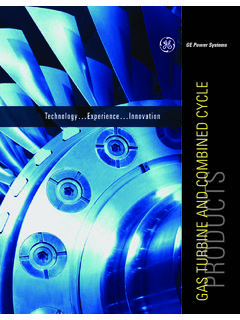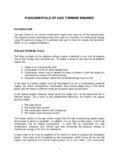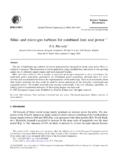Transcription of APPLIED THERMODYNAMICS TUTORIAL No.3 GAS TURBINE …
1 APPLIED THERMODYNAMICS . TUTORIAL GAS TURBINE POWER CYCLES. In this TUTORIAL you will do the following. Revise gas expansions in turbines. Revise the Joule cycle. Study the Joule cycle with friction. Extend the work to cycles with heat exchangers. Solve typical exam questions. 1. 1. REVISION OF EXPANSION AND COMPRESSION PROCESSES. When a gas is expanded from pressure p1 to pressure p2 adiabatically, the temperature ratio 1. 1 . T p . is given by the formula 2 2 . T1 p1 . The same formula may be APPLIED to a compression process. Always remember that when a gas is expanded it gets colder and when it is compressed it gets hotter.
2 The temperature change is T2 - T1. If there is friction the isentropic efficiency ( is) is expressed as is = T (ideal)/ T(actual) for a compression. is = T (actual)/ T(ideal) for an expansion. An alternative way of expressing this is with POLYTROPIC EFFICIENCY . For a compression from (1) to (2) the temperature ratio is expressed as follows. 1. p . T2 T1 2 and for an expansion from (1) to (2). p1 . 1 . p . T2 T1 2 where is called the polytropic efficiency. p1 . WORKED EXAMPLE A gas TURBINE expands 4 kg/s of air from 12 bar and 900 oC to 1 bar adiabatically with an isentropic efficiency of 87%. Calculate the exhaust temperature and the power output.
3 = cp = 1005 J/kg K. SOLUTION. T2 = T1 (1/12)1-1 = 1173 (1/12) = K. Ideal temperature change = 1173 - = K. Actual temperature change = 87% x = K. Exhaust temperature = 1173 - = K. The steady flow energy equation states . Since it is an adiabatic process = 0 so P = H/s = m cp T = 4 x 1005 x ( ). P = - x 106 W (Leaving the system). P(out) = MW. 2. SELF ASSESSMENT EXERCISE 1. A gas TURBINE expands 6 kg/s of air from 8 bar and 700 oC to 1 bar isentropically. Calculate the exhaust temperature and the power output. = cp = 1005 J/kg K. (Answers K and MW). 2. A gas TURBINE expands 3 kg/s of air from 10 bar and 920 oC to 1 bar adiabatically with an isentropic efficiency of 92%.
4 Calculate the exhaust temperature and the power output. = cp = 1010 J/kg K. (Answers K and MW). 3. A gas TURBINE expands 7 kg/s of air from 9 bar and 850oC to 1 bar adiabatically with an isentropic efficiency of 87%. Calculate the exhaust temperature and the power output. = cp = 1005 J/kg K. (Answers K and MW). 3. 2. THE BASIC GAS TURBINE CYCLE. The ideal and basic cycle is called the JOULE cycle and is also known as the constant pressure cycle because the heating and cooling processes are conducted at constant pressure. A simple layout is shown on fig. 1. Figure 1 Illustrative diagram. The cycle in block diagram form is shown on fig.
5 2. Block diagram 4. There are 4 ideal processes in the cycle. 1-2 Reversible adiabatic (isentropic) compression requiring power input. Pin= H/s = m cp (T2-T1). 2-3 Constant pressure heating requiring heat input. in = H/s = m cp (T3-T2). 3-4 Reversible adiabatic (isentropic) expansion producing power output. Pout = H/s = m cp (T3-T4). 4-1 Constant pressure cooling back to the original state requiring heat removal. out = H/s = m cp (T4-T1). The pressure - volume, pressure - enthalpy and temperature-entropy diagrams are shown on figs. 3a, 3b and 3c respectively. Fig 3a p-V diagram Fig 3b p-h diagram Fig 3c T-s diagram EFFICIENCY.
6 The efficiency is found by applying the first law of THERMODYNAMICS . nett Pnett in - out Pout - Pin Pnett mc p (T4 - T1 ) (T - T ). th 1 out 1 1 4 1. in in mc p (T3 - T2 ) (T3 - T2 ). It assumed that the mass and the specific heats are the same for the heater and cooler. It is easy to show that the temperature ratio for the TURBINE and compressor are the same. 1 1. 1 1 . T2 p 2 T3 p3 . 1 1. 1 1 T3 T2. rp . rp .. T1 p1 T4 p 4 T4 T1. rp is the pressure compression ratio for the TURBINE and compressor. 5. T3T1 T . - T1 T1 3 - 1 . th 1 4 1 1 - 2 1 T2 . (T - T ) T. (T3 - T2 ) T2T4 T . - T2 T2 4 - 1 . T1 T1.
7 T3 T4 T3 T. -1 4 -1. T2 T1 T2 T1. T1 T 1. th 1 1 4 1 1 1 rp since T2 T3 1 . rp . This shows that the efficiency depends only on the pressure ratio which in turn affects the hottest temperature in the cycle. 6. WORKED EXAMPLE A gas TURBINE uses the Joule cycle. The pressure ratio is 6/1. The inlet temperature to the compressor is 10oC. The flow rate of air is kg/s. The temperature at inlet to the TURBINE is 950oC. Calculate the following. i. The cycle efficiency. ii. The heat transfer into the heater. iii. The net power output. = cp = kJ/kg K. SOLUTION. th 1 rp 1 6 or 40%. T2 T1 283 x 6 K. in mc p (T3 - T2 ) x x (1223 - ) kW.
8 Pnett th . in Pnett x kW. SELF ASSESSMENT EXERCISE A gas TURBINE uses the Joule cycle. The inlet pressure and temperature to the compressor are respectively 1 bar and -10oC. After constant pressure heating, the pressure and temperature are 7 bar and 700 oC respectively. The flow rate of air is kg/s. Calculate the following. 1. The cycle efficiency. 2. The heat transfer into the heater. 3. the nett power output. = cp = kJ/kg K. (Answers % , kW and kW). 7. 3. THE EFFECT OF FRICTION ON THE JOULE CYCLE. TURBINE . The isentropic efficiency for a gas TURBINE is given by: i = (Actual change in enthalpy)/(Ideal change in enthalpy).
9 I = (Actual change in temperature)/(Ideal change in temperature). COMPRESSOR. For a compressor the isentropic efficiency is inverted and becomes as follows. i = (Ideal change in enthalpy)/(Actual change in enthalpy). hi = (Ideal change in temperature)/(Actual change in temperature). Remember that friction always produces a smaller change in temperature than for the ideal case. This is shown on the T-s diagrams ( and 4b). TURBINE expansion. Compression process. i = (T3 T4)/(T3 T4') i = (T2' T1)/(T2 T1). The power output from the TURBINE is hence P(out) = m cp (T3 T4') i The power input to the compressor is hence P(in) = m cp (T2' T1)/ i THE CYCLE WITH FRICTION.
10 It can be seen that the effect of friction on the gas TURBINE cycle is reduced power output and increased power input with an overall reduction in nett power and thermal efficiency. Figs. 5a and 5b show the effect of friction on T-s and p-h diagrams for the Joule cycle. Temperature - Entropy Pressure - Enthalpy 8. Note the energy balance which exists is P(in) + (in) = P(out) + (out) P(nett) = P(out) - P(in) = (nett) = (in) - (out). WORKED EXAMPLE A Joule Cycle uses a pressure ratio of 8. Calculate the air standard efficiency. The isentropic efficiency of the TURBINE and compressor are both 90%. The low pressure in the cycle is 120 kPa.


















